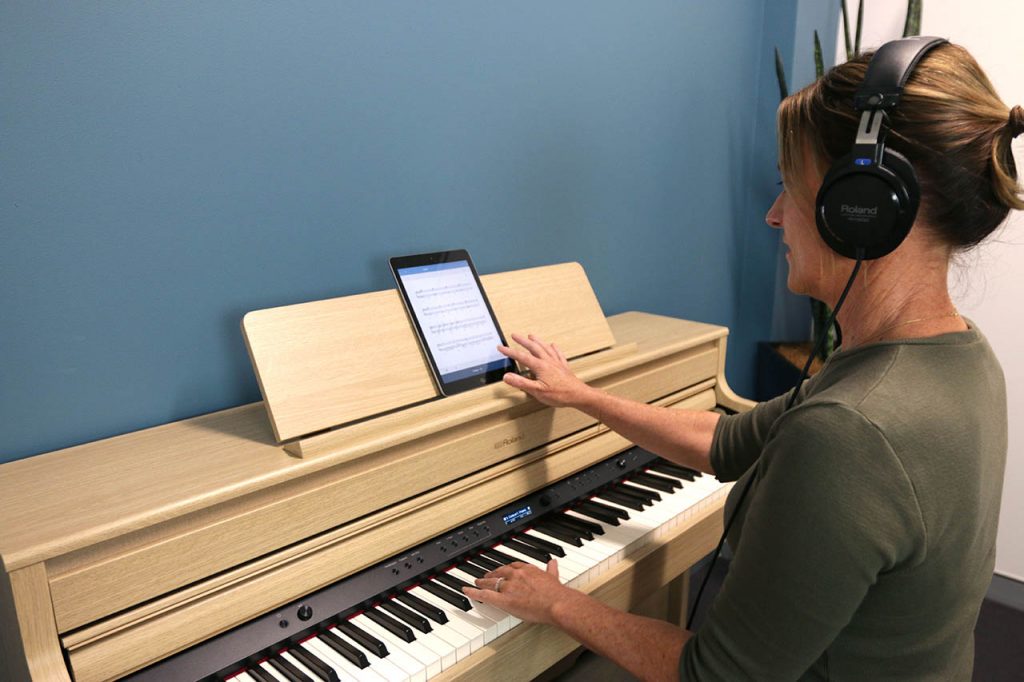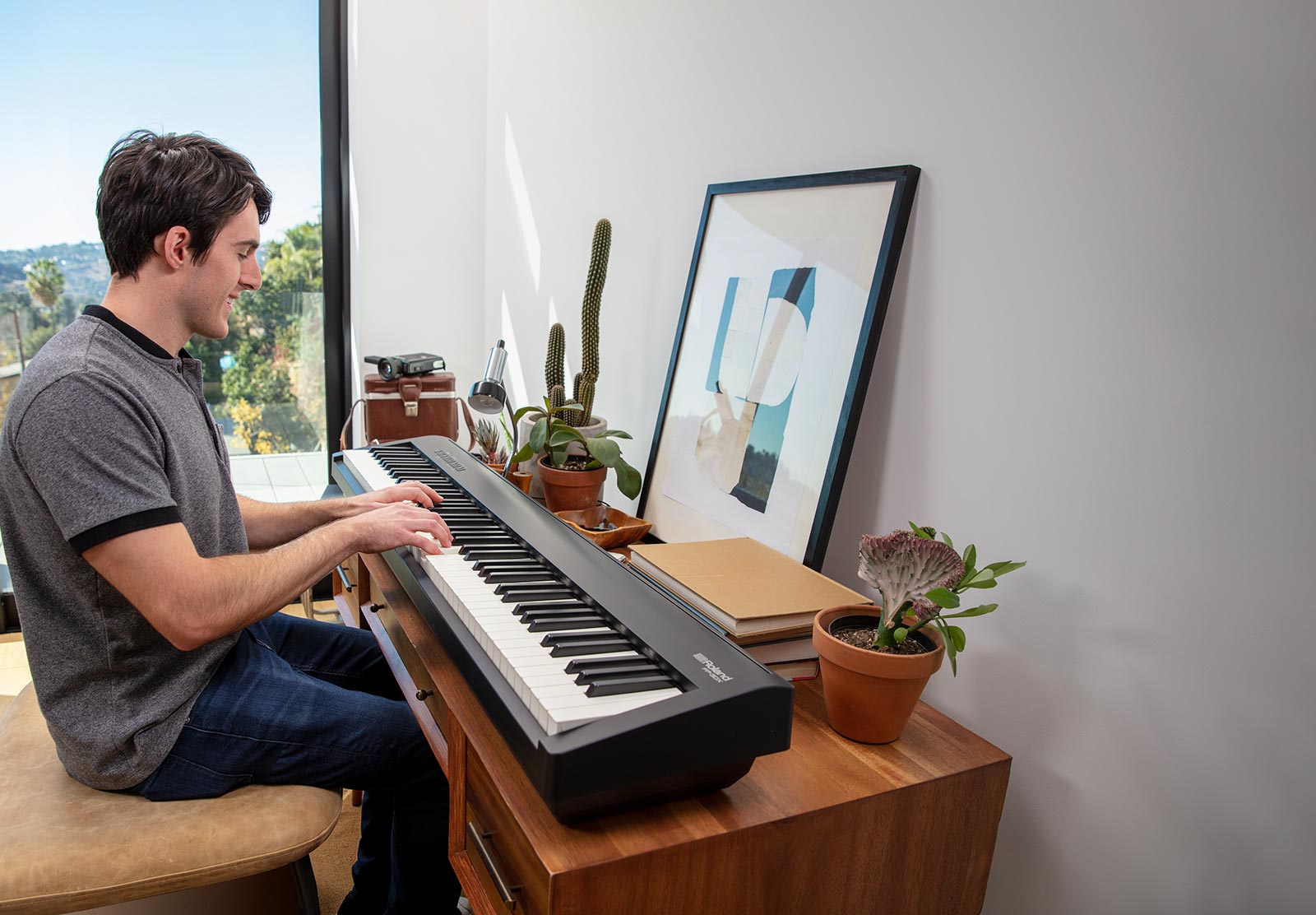Playing piano provides the backbone of a solid musical foundation. Some musicians fall in love with performing, while others utilize the piano as a compositional tool. Studying with a piano can accelerate your education in harmony, sight-reading, and ear training. But, with so many acoustic and digital options, how do you find the right match for your needs? We’re here to help you plan and jump-start your piano journey.
Table of Contents
Comparing Acoustic and Digital Pianos
Acoustic Pianos
A decent acoustic piano will likely cost thousands of dollars. A great acoustic piano may cost more than the down payment on a house. And there are other expenditures as well. Acoustic piano owners should hire a professional tuner at least twice a year. In addition, over time, wear and tear will require repairs. Sure, a well-built acoustic piano can endure for decades. However, it will demand your consistent attention and care.
Digital Pianos
Digital pianos are much more low-maintenance than their acoustic counterparts. Since they never go out of tune, they’re fantastic for novices who need a reliable ear-trainer. Many digital pianos are travel-friendly and affordable. Also, they sound great through headphones for practice and recording sessions. Nowadays, digital pianos have extensive preset libraries beyond classics like harpsichord and organ. The sound design possibilities are endless.
"Nowadays, digital pianos have extensive preset libraries beyond classics like harpsichord and organ. The sound design possibilities are endless."
Acoustic pianos require physical adjustments to alter tone. For example, a piano player must close the cabinet or use a practice pedal to achieve a darker timbre. By contrast, getting a warm tone from a digital piano is as easy as picking a preset. In addition, tools like Roland Piano Designer offer powerful tonal adjustment options. This app allows users to finely adjust sound elements like a piano technician fine-tunes an acoustic piano. You can tame the high frequencies with the built-in EQ on some advanced models. A digital piano can also transform into a MIDI controller when needed. That fact alone makes it an attractive choice for anyone interested in producing music with a DAW.

Hybrid Pianos
Want the best of both worlds? Then, a hybrid piano may be the right fit for you. You can play a hybrid piano with or without headphones. You can record a hybrid piano with microphones or plug it into your audio interface. You can also use it as a MIDI controller to play any virtual instrument on your computer. What’s not to like?
Still, there are a few considerations. For one, any hybrid worth the investment is even more expensive than upper-tier digital pianos. In fact, some high-end options are even pricier than their acoustic counterparts. Secondly, you’ll still need a piano tuner for maintenance. In many ways, a hybrid piano requires as big a commitment as an acoustic.
Grand, Upright, and Portable Pianos
Grand Versus Upright
Choosing between grand and upright is a cosmetic decision if you’re looking for a digital piano. But with acoustic and hybrids, you’ll notice that the volume and tone get richer as you size up.
That said, some spaces are better than others for a concert grand piano. A baby grand may sound resonant and muddy in a small, acoustically untreated room. Grand pianos usually stay in concert halls and recording studios for a reason. The larger the cabinet, the more accurate the overtones will be. Bass notes will have more impact, and high notes will reverberate without harshness. But these sonic details shine best in the right environment.

With that in mind, upright varieties should be on your radar even if you have the budget and space for a grand. Among upright pianos, there are various cabinet sizes, too. Each comes with its advantages and disadvantages in cost, tone, and volume. Luckily, you can always visit a few showrooms before you make your final decision.
Are you still dreaming of a grand piano with dashing looks? Then, you’re better off investing in a digital version like Roland’s GP-9, which sounds excellent in any space.
"Grand pianos usually stay in concert halls and recording studios for a reason. The larger the cabinet, the more accurate the overtones will be."
Portability Versus Playability
As beautiful as they can be, acoustic and hybrid pianos are unsuitable for traveling. A luxurious digital piano like the LX708, too, should be stationed at a designated spot. Still, there are plenty of portable options for performers.
Back in the day, portable digital pianos didn’t even come close to the experience of playing an acoustic. The keys would feel too light against the touch, and the resulting sound would be bearable at best. This is no longer true, thanks to superior models like the FP-90X. With its weighted keys and advanced sound system, the FP-90X is portable and playable. A benefit of digital pianos is the ease of putting them in apartments or second floors of homes, thanks to their flat-pack form.

Form Versus Function
Although function comes first, you shouldn’t ignore how a piano fits in with the interior design of your room. Roland’s Piano AR technology takes the guesswork out of the equation. View how each piano looks in your space before you purchase. And, for helpful design tips, bookmark “Piano Meets Home Decor.” With a few elegant touches, your practice space might become your favorite home spot.
Piano Features
Speaking of function—it’s always a good idea to list the pros and cons for each model you’re considering.
Number of Keys
A full-size digital piano has the identical number of keys a standard acoustic piano does: 88. Go far enough to play a challenging sonata by Lizst, and you may have to reach for some of the lowest keys. In such a case, a 61-key piano falls short. On the other hand, most pop and jazz keyboardists find five octaves to be perfectly adequate. Therefore, the GO-61P or GO-61K may be perfect if you’re after an easy-to-store, affordable solution.
Weighted Versus Non-weighted Keys
Weighted keys will help you develop the strength necessary to play with an expansive emotional and dynamic range. It’ll also boost your dexterity. You might make a mistake or two when you switch to an analog synth with lighter keys. Still, you’ll be able to adapt quickly. Are you going from practicing on non-weighted keys for several years to playing an acoustic grand for the first time? Be prepared to feel like you’re climbing up a mountain without proper training.
This is why piano instructors advise parents that weighted keys are essential to a child’s musical education. The sooner you start building your finger muscles, the better.
"Piano instructors advise parents that weighted keys are essential to a child’s musical education. The sooner you start building your finger muscles, the better."

Pedals
On most pianos, you’ll see three pedals attached at the bottom. The one on the left is the soft pedal, which softens the sound. On the right is the sustain pedal, which sustains each note you play. As for the middle pedal, its function depends on the design of the piano to which it belongs.
In most upright pianos, the middle pedal dampens the sound even more than the soft pedal. In such a case, people refer to it as the practice pedal. With a hybrid, you can lock the middle pedal to mute the acoustic strings of your piano altogether. This way, you can still practice with the same weighted keys. What you hear through your headphones, however, is the sampled sounds of your piano playing back.
The Roland middle or Sostenuto pedal is similar to a sustain pedal. The key difference is that it only holds notes that are already being played at the moment when the pedal is pressed down. Any notes that begin after the pedal is down are not affected, allowing for selective sustain without blurring the sound.
Most pianos come with their own set of pedals. Some portable digital pianos don’t include pedals in the packaging, but you can purchase them separately.
The Piano Lifestyle
Age to Start
You’re never too old to learn how to play an instrument. Playing the piano can be a hobby you delve into even in retirement. However, it certainly doesn’t hurt to start at an early age. Most prodigies begin taking piano lessons at the age of three or four. At that point, the goal is to train the ear and implement the correct hand positions more than anything else. Most children can’t read and play music until 5 to 9.
If your toddler enjoys singing or dancing, leave some musical toys around and observe their behavior. The next step can be obtaining a small, two-octave keyboard. After that, you can try color-coding the keys. An orange sticker could go on C, whereas the purple one marks the E key. Pay close attention to how they interact with the marked keys. Do they attempt to play simple melodies? Then, they may be ready for their first piano lesson.

Health Benefits
A musical education doesn’t have to serve a professional purpose. Based on numerous clinical studies, piano lessons are proven to lighten the load of emotional and mental obstacles. They constitute a support system for depressed individuals who struggle with anxiety. They reawaken experiences from a distant past in patients battling memory loss. They provide a unique outlet for improving eye and hand coordination. Who knows in what ways playing the piano will stimulate your mind? You won’t find out until you try.
"Based on numerous clinical studies, piano lessons are proven to lighten the load of emotional and mental obstacles."
Learning Online
After purchasing a piano, you might need some time to recoup financially. But you don’t have to wait to start your education when there’s a plethora of online resources. Consider taking some free courses from a dependable site like Soundfly. “Building Blocks of Piano” and “Music Theory for Beginner Pianists” are good choices.
And, if you own a Roland piano, there are companion apps you can download for free. The Roland Piano App has hundreds of sheet music, ear training exercises, and a recorder for performance evaluation.

Recording and Sharing
Building a community around your piano learning journey will urge you to challenge yourself to get better. With Roland’s piano apps, recording and sharing your practice routines on social media is easy. But let’s face it—the built-in microphone on your tablet or smartphone can’t capture the quality of sound you hear when you play at home.
A tool like Roland’s GO:MIXER can take your music content game to the next level. With GO:MIXER, you can record high-quality audio on your smartphone. It also works with the camera app, which eliminates the need for fancy video editing software. Just hit record, play, and share whenever you feel like it.
Ready to dive into the world of piano? Take a look at the wide selection of Roland digital pianos here.







